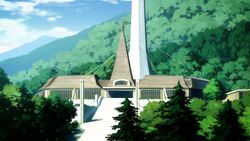
Sage Academy (全人学級 Zenjin gakkei) is the second and final school students in Kamisu 66 attend. A student graduates from any previous school (e.g. Harmony School) when they gain the ability to use their Cantus (commonly referred to as having being visited by the "Spirit of Blessing") and have their Cantus sealed and Mantra bestowed at the Temple of Purity afterwards, after which they enroll into the Sage Academy.
Description[]
- All the practical courses at Sage Academy are based on each student's aptitude. Although the general technique for using cantus is the same, there are hundreds of levels of difficulty, from simple force exchange to something as advanced as cold fusion. While most students progress averagely, some students are able to tackle much harder techniques. One example is Shun, whose progress is far ahead of his other classmates. During one course, he is given the task of hatching a chick from its egg in under two hours, an incredibly difficult task since it normally takes an egg twenty-one days to hatch. To be given permission to use cantus directly on a living being requires not only technical skill, but also recognition of outstanding character, so it is common that there are incredibly high expectations for the future of each student who gets the permission to try such a difficult task. In order to master the delicate touch needed to control their cantus, all students have to create a magic mirror.
Summer Camp[]
- Summer Camp is an important event that is held every year. Even though the name makes it sound happy and carefree, it is actually an action-packed week-long camp where the teams paddle up the Tone River and live in tents without any adult supervision. Students have to have their teacher approve their itinerary to make sure it does not clash with another team's schedule, but that is the only input they get.[1]
The Ball Tournament[]
- The Ball Tournament is a kind of strategy game in Sage Academy where students have to come up with a basic strategy, make a working pusher, attackers and defenders out of clay, and learn to control them perfectly, and then have a battle against another group of students.[2]
- There are two teams, the offense and the defense. The offense rolls a large marble ball across the field into the goal while the defense tries to block. The total time allowed for one round is ten minutes, and the team that takes the least time to score a goal is the winner. In the case where neither side scores, both teams play defense as well as offense in a tiebreaker match where the first team to score wins.[2]
- Throughout the match, one can only use their cantus, but there is one serious restriction. No one is allowed to alter the ball or the field with their cantus. That means each students has to be good at controlling their pieces. In addition, the pieces are not allowed to lose contact with the ground - If students were allowed to use floating pieces, they would be able to use the ball to absorb any impacts the pusher might sustain.[2]
- The field constructed in the inner courtyard of the school is two meters wide and ten meters long, and paved with sandy dirt and patches of grass so that it required considerable concentration just to push the ball in the a straight line. The defense can put the goal wherever they want, but cannot do anything else, like making potholes or mountains to protect it.[2]
- The pieces only have to be within the weight limits. Students are free to decide what shape, or how many pieces they wanted to use, but the more pieces they use, the harder it is to control them all. One more important restriction is that students are not allowed to attack the opponent's pusher. Otherwise, everyone would just target the pusher and it would be destroyed before the other team had a chance to do anything. However, only one pusher is immune to attack, so while they are allowed to use more than one, it is disadvantageous to do so. Most teams only use one pusher.[2]
See also[]
References & Citations[]


